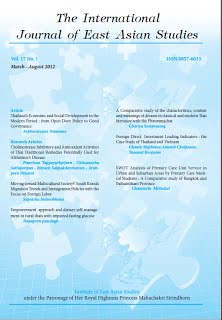Foreign Direct Investment Leading Indicators: the Case Study of Thailand and Vietnam
Keywords:
Foreign Direct Investment, Leading Indicator, ARIMAX modelAbstract
Background: Foreign direct investment (FDI) has played the important role in economic
development, both for Thailand and Vietnam. In order to explain FDI patterns in Thailand and in Vietnam for the past 20 years, ARIMAX model is employed. The ARIMAX model, as well, is used to forecast the value of FDI in these two countries.
Objective: The objective of this paper is to construct the leading indicators that are able
to explain and predict the behaviors of foreign direct investment infl ow to Thailand and Vietnam. The paper introduces ARIMAX model to explain and predict the value FDI infl ow to these two countries. Data used in this paper is quarterly data during the period of 1988-2010.
Result: The study f inds that GDP per capita, real interest rate, degree of openness, and exchange rate are the leading indicators for explaining and forecasting the FDI values to these two countries. Among these factors, degree of openness is the most important factor to explain the FDI pattern.
Discussion and Conclusion: The study f inds that investment promotion policies and the
reduction in trade transaction costs play the important role in FDI decision. The model forecasts that the value of FDI to both countries would be converge the same in the first quarter of 2012.



